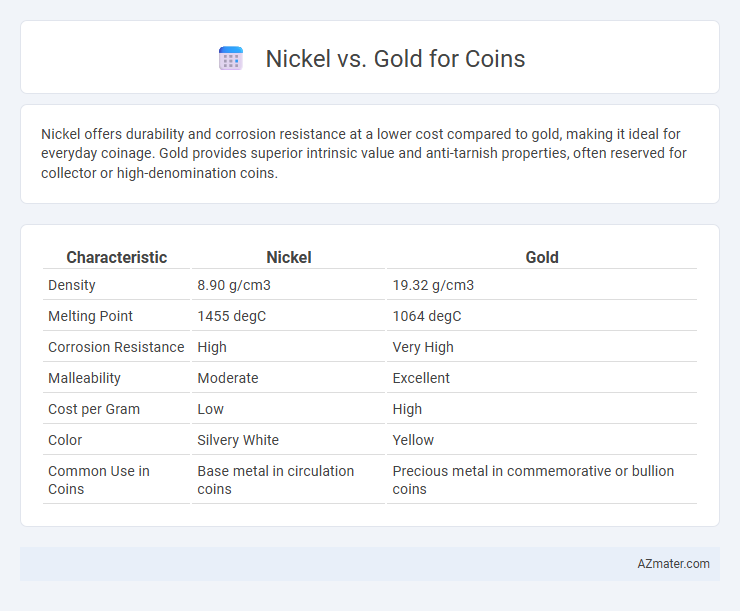Nickel offers durability and corrosion resistance at a lower cost compared to gold, making it ideal for everyday coinage. Gold provides superior intrinsic value and anti-tarnish properties, often reserved for collector or high-denomination coins.
Table of Comparison
| Characteristic | Nickel | Gold |
|---|---|---|
| Density | 8.90 g/cm3 | 19.32 g/cm3 |
| Melting Point | 1455 degC | 1064 degC |
| Corrosion Resistance | High | Very High |
| Malleability | Moderate | Excellent |
| Cost per Gram | Low | High |
| Color | Silvery White | Yellow |
| Common Use in Coins | Base metal in circulation coins | Precious metal in commemorative or bullion coins |
Overview: Nickel vs Gold in Coinage
Nickel and gold serve distinct purposes in coinage, with nickel primarily valued for durability and cost-effectiveness in circulating coins, while gold is prized for its intrinsic value and use in commemorative or investment-grade coins. Nickel alloys are corrosion-resistant and suitable for high-volume minting, making them ideal for everyday currency. Gold coins, though more expensive to produce, retain value due to their rarity and appeal among collectors and investors.
Historical Use of Nickel and Gold in Coins
Nickel has been widely used in coinage since the late 19th century due to its durability and resistance to corrosion, making it a practical choice for everyday currency. Gold, valued for its rarity and aesthetic appeal, has historically been used in coins primarily for high-value denominations and as a standard for wealth and monetary stability. Both metals have shaped numismatic history, with nickel favored for circulation coins and gold reserved for commemorative, investment, and bullion coins.
Physical and Chemical Properties Comparison
Nickel exhibits higher hardness and corrosion resistance compared to gold, making it more durable for coins subjected to frequent handling. Gold is denser and softer, offering superior malleability and resistance to tarnish due to its inert chemical nature. Both metals differ significantly in conductivity and reactivity, with nickel being more reactive and gold maintaining stability under various environmental conditions.
Durability and Longevity of Nickel vs Gold Coins
Nickel coins exhibit superior durability compared to gold coins due to nickel's hardness and resistance to corrosion, making them less prone to wear and damage in everyday circulation. Gold coins, while highly resistant to tarnish, are softer and more malleable, which can lead to surface scratches and deformation over time. The longevity of nickel coins in circulation is generally greater, as their robust composition withstands frequent handling and environmental stress better than gold coins.
Economic Value: Cost and Market Price Differences
Nickel coins offer a lower production cost due to the metal's abundance and affordability, making them economically viable for everyday currency use. In contrast, gold coins possess significantly higher market prices driven by gold's scarcity, intrinsic value, and demand as a hedge against inflation. The stark disparity in material cost affects the coins' economic value, with gold dominated by investment appeal and nickel by practical circulation.
Collectability and Rarity: Nickel vs Gold Coins
Gold coins hold significantly higher collectability and rarity compared to nickel coins due to their intrinsic value, historical significance, and limited mintage, attracting serious investors and collectors. Nickel coins, often produced in larger quantities for everyday circulation, tend to have lower rarity but can still be highly collectible if they feature unique designs, mint errors, or are part of limited commemorative issues. The scarcity of gold combined with its resistance to corrosion enhances its desirability and long-term value in the numismatic market over more commonly available nickel coins.
Anti-Counterfeiting Features and Security
Nickel coins incorporate complex electromagnetic signatures and micro-engraving technologies to enhance anti-counterfeiting measures, making them more difficult to replicate compared to gold coins. Gold coins rely on intrinsic material value and weight precision for security, but their softness limits the use of advanced surface security features. Nickel alloys offer greater durability, allowing for the integration of advanced security elements like latent images and RFID tags, significantly improving counterfeit detection.
Environmental Impact of Mining and Production
Nickel mining generates significant environmental concerns due to its energy-intensive extraction process and harmful waste byproducts such as acid mine drainage, which can contaminate local water systems. Gold mining also poses severe environmental risks, including habitat destruction, mercury and cyanide pollution, and substantial carbon emissions from ore processing. Both metals require intensive resource use, but gold's environmental footprint tends to be larger per unit weight due to more complex refining and lower ore grades.
Industrial and Modern Applications in Currency
Nickel's durability and corrosion resistance make it a preferred choice for modern coinage, especially in industrial and high-circulation currencies. Gold, valued for its rarity and intrinsic worth, is primarily used in commemorative coins and high-value currency reserves rather than everyday transactions. Industrial applications favor nickel alloys for their strength and cost-effectiveness, while gold maintains a key role in investment-grade and collectible coins.
Choosing the Best Metal for Coinage: Conclusion
Nickel offers superior durability and resistance to corrosion, making it a practical choice for coins in high circulation. Gold provides exceptional intrinsic value and aesthetic appeal, suited for commemorative or collectible coins. Selecting the best metal depends on balancing durability, cost, and purpose, with nickel favored for everyday use and gold preferred for investment or prestige.

Infographic: Nickel vs Gold for Coin
 azmater.com
azmater.com